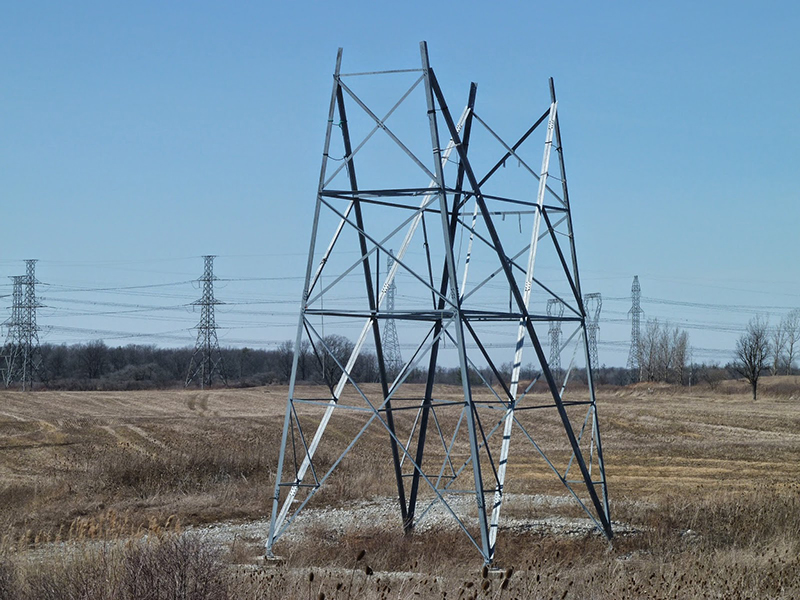
Six Nations A6N workers are preparing to head back to the work at the Niagara Reinforcement Line after a three month shutdown revolving around a governance dispute.
Six Nations of the Grand River Development Corporation, who owns A6N — the construction contractor hired to complete the power line — put out a public call inviting members of the Six Nations community to come to the construction site as workers return in a show of support.
Another call out followed across social media a short time later from vocal opponents of the SNGRDC’s deal with Hydro One — inviting Six Nations residents to come to the site to oppose work continuing.
The dispute is a case-in-point of Six Nations deepening governance issues surrounding development on lands where the Haudenosaunee hold treaty rights, and which governance body developers work with: the Six Nations Elected Council or the Haudenosaunee Confederacy Chiefs Council.
HISTORY OF THE DISPUTE
In 2006, during the Caledonia reclamation of the housing development at Douglas Creek Estates, work on a new power line crossing the property was shut down mostly due to its proximity to the land dispute.
That powerline sat dormant for over a decade. In the meantime, talks were revived a few times between Hydro One, the HCCC and SNEC to see the project completed and electricity flowing through the powerline.
In the summer of 2012, the Haudenosaunee Development Institute made two attempts at making some progress toward it’s own deal with Hydro One to get the line completed.
According to an HDI report to the HCCC, HDI was involved in talks with the Abor Group in January 2012 to see a deal to complete the line. That proposal was rejected on the grounds that the SNEC were party to it’s engagement process and HCCC did not want that.
A second attempt to craft an HCCC deal on the line came in the summer of 2012, when HDI attempted to pair negotiations on the NRL during it’s consultations with the Niagara Region Wind Corporation.
HDI says discussions fell flat when Hydro One informed them they required Six Nations Elected Council to participate in any negotiation process. HDI says they abandoned those discussions following a directive by the HCCC.
A third attempt was made in February 2015 when HCCC’s Haudenosaunee Wildlife Habitat Authority requested to take the lead on negotiating an agreement for the line. However that attempt fizzled out when HCCC directed the Habitat Authority to work together with HDI and no one followed up on doing the work.
THE CURRENT AGREEMENT
In September 2017, Hydro One and SNGRDC entered into a memorandum of understanding to complete the NRL.
From October 2017 to January 2018 the Development Corporation held community engagement sessions to see if the community would approve or reject it’s involvement in the project.
In February 2018, the SNGRDC Advisory Committee recommended the Development Corporation accept the proposal. Later that month the Elected Council unanimously ratified that decision.
SNEC then allocated a $12.5 million payment it received from a different agreement with the OLG and invested that money into a 25% equity position in the NRL — making the acquisition a debt free investment for Six Nations that is expected to generate $46 million to the community.
The final agreement was signed between the Development Corporation, SNEC and Hydro One in May 2018. Construction on the line began in October 2018.
WORK SHUTDOWN BY HCCC
According to Hydro One’s interim public report, construction on the transmission line was then halted on January 21 to consider concerns raised by the Haudenosaunee Confederacy Chiefs Council (HCCC). “The HCCC asserts it was not properly consulted about this project prior to construction commencement. We are working with our partner, Six Nations of the Grand River, to determine appropriate steps to be taken to resume construction,” said the report.
SNGRDC says the HCCC passed a resolution in a Confederacy Council meeting in January 2019 to send a delegation of people to halt construction on the line and deliver a cease and desist letter to A6N construction workers on site. The letter, demanded work halt on the line immediately and insisted the HCCC get a meeting with Hydro One.
In February 2019 the SNGRDC posted public information outlining the problems they were facing and asking the HCCC publicly to lift their cease and desist demand on line construction.
At that meeting, HCCC sent a representative, Colin Martin, to read a letter, claimed the HCCC had no knowledge of agreements between Hydro One and SNGRDC to complete the line.
“We learned of the deal made with Hydro One, not from the Development Corporation, but from an outside investment firm that we have no entered into an agreement with,” says the letter.
However, minutes posted to the HCCC’s own website prove that claim to be untrue. In December 2017 HDI presented an extensive background on the previous attempts made to reach an agreement with Hydron One and the current agreement being proposed between the Development Corporation and Hydro One.
A second update was given to the HCCC in May 2018 which says, “as we have previously advised, the proposed construction of the Niagara Reinforcement Line is intended to proceed through the lands at Kanonhstaton.”
Additionally, SNGRDC held a public meeting on February 19 to inform the Six Nations community about the cease and desist letter from the HCCC. During the meeting the Development Corporation shared details on three emails they say were sent to HCCC’s Council Secretary Leroy “Jock” Hill to inform the HCCC about the line completion.








